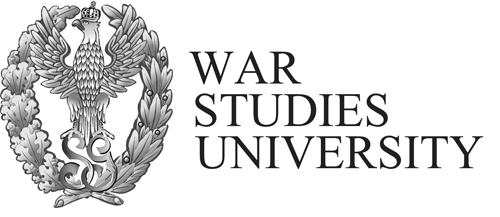Online first
Current issue
All issues
About
Aims and scope
Peer review process
Publication policy and ethics & malpractice statement
Editorial Board
Reviewers
Publisher
Guide for authors
Call for papers
Book Reviews
Special Issues Archive
New and emerging technologies in defence education, training and governance
The military-geographical significance of the Suwałki Gap
1
War Studies University
Publication date: 2017-12-31
Security and Defence Quarterly 2017;17(4):3-20
KEYWORDS
ABSTRACT
Dynamic changes in the security environment are forcing us to reflect on the shape of the
international order at the end of the second decade of the 21st century. The aggressive
policy of the Russian Federation, which is confirmed by the conflict with Georgia in 2008
and the current situation in Ukraine, indicates that the use of military violence in the
resolution of international disputes is not a historical category at all. This is of particular
importance to the geopolitical location of the Republic of Poland. The length of our land
border with the Russian Federation is 210 km, while with Belarus it is 418 km. The above
fact has a fundamental impact not only on the public debate on the security of our country
and the region, but also, and perhaps most importantly, on the shape of defence policy
and the content of planning possible measures to prevent and counteract the escalation
of prospective tensions in NATO-Russia relations. Both Russian military doctrine and
the opinions expressed by politicians and specialists dealing with military issues and
political and military experts indicate that, from the Russian perspective, the Baltic
States’ membership of the North Atlantic Alliance and the presence of NATO troops on
the territory of these countries, is highly unfavourable. Therefore, there are grounds to
believe that countries such as Lithuania, Latvia and Estonia, are treated by Russia as
natural bridgeheads, convenient for bringing possible strikes against Russia. Therefore, it
is possible that blocking communication routes leading to these countries, while cutting
them off from the support of allied land forces, may prove to be a key success factor in the
situation of a hypothetical armed conflict, aimed not only at depriving these countries of
their sovereignty, but also aimed at discrediting the power of the Alliance.
REFERENCES (22)
1.
Banasik, M. and Parafianowicz, R., 2015. Teoria i praktyka działań hybrydowych. Zeszyty Naukowe Akademii Obrony Narodowej, 2 (99).
3.
Bujak, A., 2000. Środowisko a Działania Bojowe na Terytorium Polski. Wydawnictwo Adam Marszałek, Toruń.
4.
Dubiński, P., 2015. Przesmyk suwalski kluczem do planów Rosji. Putin wykorzysta słabość NATO? 11 December, [online]. Available from: https://wiadomosci.wp.pl/przes...- suwalski-kluczem-do-planow-rosji-putin-wykorzysta-slabosc-nato-6025251129053825a [Accessed 16 Mar 2018].
5.
Dudzińska, K., 2012. (Nie) rozwiązany problem mniejszości narodowych w państwach bałtyckich. Biuletyn PISM, 30 (895), 23 March.
6.
Generalna Dyrekcja Dróg Krajowych i Autostrad, 2017. Via Baltica. [online]. Available from: https://www.gddkia.gov.pl/fron...- odcinki-s61-w-r_27555/Via%20Baltica%2031%20pa%C5%BAdziernika%202017.pdf [Accessed 23 Mar 2018].
7.
Grzelak, C. and Kozłowski, E., 1994. Polski wrzesień 1939. Początek drogi w obronie wolności i niepodległości. Warsaw.
8.
Kondracki, J., 1998. Geografia Regionalna Polski. Wydawnictwo Naukowe PWN, Warszawa.
9.
Kowalski, W., 1999. U Polskich Stoim Granic. Opowieść o Żołnierzach Baonu KOP „Sejny”. Wydawnictwo Hańcza, Suwałki.
10.
Obwód kaliningradzki, in Wikipedia: Th e Free Encyclopedia, [online]. Available from: https://pl.wikipedia.org/wiki/... [Accessed 16 Mar 2018].
11.
Parafianowicz R., 2015. Podziemie Niepodległościowe na Suwalszczyźnie 1944-1952. Ofi cyna Wydawnicza Rytm, Warsaw.
12.
Polskieradio.pl, 2011. Wspomnienia z czasów wojny i trudnego pokoju. 27 March, [online]. Available from: http://www.polskieradio.pl/8/7...- czasow-wojny-i-trudnego-pokoju [Accessed 16 Mar 2018].
13.
Przesmyk suwalski, in Wikipedia: The Free Encyclopedia, [online]. Available from: https:// pl.wikipedia.org/wiki/Przesmyk_suwalski [Accessed 23 Mar 2018].
14.
Rogacin, W., 2016. Atlantic Council: Korytarz suwalski to słaby punkt NATO. Rosjanie mogliby podzielić Sojusz. Polska The Times, 15 February, [online]. Available from: http://www.polskatimes.pl/arty...- slaby-punkt-nato-rosjanie-mogliby-podzielic-sojusz,id,t.html [Accessed 16 Mar 2018].
15.
Skrzyp J. and Lach Z., 2008. Geostrategiczne Położenie Polski przed i po Transformacji Ustrojowej. Akademia Obrony Narodowej, Warsaw.
16.
Skrzyp, J., 1993. Wojskowo-geograficzna Charakterystyka Polski Północno-Wschodniej (Mazurski Rejon Operacyjny). Materiały do studiowania. AON, Warsaw.
17.
Skrzyp, J., 1999. Geostrategiczne Aspekty Bezpieczeństwa Polski. Wydawnictwo MON, Warsaw.
18.
Ściobiorek, Z., 2017. Militarne znaki zapytania na wschodzie. Kwartalnik Bellona, 1.
19.
Telewizjarepublika.pl, 2015. Dowódca sił USA w Europie ostrzega: Rosjanie mogą zamknąć Morze Bałtyckie. 2 October, [online]. Available from: http://telewizjarepublika.pl/ dowodca-sil-usa-w-europie-ostrzega-rosjanie-moga-zamknac-morze-baltyckie,24352. html?fb_comment_id=967477986645263_967481413311587 [Accessed 16 Mar 2018].
20.
tvn24, [online]. Available from: https://www.tvn24.pl/wideo/z-a...- na-polakow-w-manewrach,239810.html?playlist_id=22128 [Accessed 16 Mar 2018].
21.
wPolityce.pl, 2015. Były doradca Putina nie pozostawia złudzeń: Atak Rosji na kraje bałtyckie i Polskę jest nieuchronny. Nastąpi w ciągu dwóch lat. 11 January, [online]. Available from: http://wpolityce.pl/swiat/2292...- atak-rosji-na-kraje-baltyckie-i-polske-jest-nieuchronny-nastapi-w-ciagu-dwoch-lat [Accessed 16 Mar 2018].
22.
wPolityce.pl, 2016. Prawdziwe wzmocnienie bezpieczeństwa?! „FT”: batalion NATO w Polsce będzie rozmieszczony w przesmyku suwalskim. 15 June, [online]. Available from: https:// wpolityce.pl/polityka/296718-prawdziwe-wzmocnienie-bezpieczenstwa-ft-batalion-nato- w-polsce-bedzie-rozmieszczony-w-przesmyku-suwalskim [Accessed 23 Mar 2018].
CITATIONS (6):
1.
2.
Brexit: Analysing Britain’s political and geostrategic considerations
Muhammad Baig, Richard Meissner
Cogent Social Sciences
Muhammad Baig, Richard Meissner
Cogent Social Sciences
3.
Recent U.S. and International Assessment of Baltic Security Developments
Bert Chapman
Security and Defence Quarterly
Bert Chapman
Security and Defence Quarterly
4.
THE SUWAŁKI GAP AS A SECURITY PROBLEM OF LITHUANIA AND THE EASTERN FLANK OF THE AREA OF NATO RESPONSIBILITY
Іnna Turianytsia
European Historical Studies
Іnna Turianytsia
European Historical Studies
5.
Don’t count on the U.S.: can Russia achieve a rapid breakthrough in central Europe?
Jan Kofroň, Jakub Stauber
European Security
Jan Kofroň, Jakub Stauber
European Security
6.
Electro-Mechanical Multi Spotlight: Monitoring of High Risk Areas by Small-Satellite SAR
Leszek Lamentowski, Vladimir Ignatenko, Ozan Dogan, Darren Muff, Matthew Nottingham, Pierre Leprovost, Andrea Radius, Jan Krecke, Tuomas Tajakka, Maria Arbenina
2025 IEEE Radar Conference (RadarConf25)
Leszek Lamentowski, Vladimir Ignatenko, Ozan Dogan, Darren Muff, Matthew Nottingham, Pierre Leprovost, Andrea Radius, Jan Krecke, Tuomas Tajakka, Maria Arbenina
2025 IEEE Radar Conference (RadarConf25)
Share
RELATED ARTICLE
We process personal data collected when visiting the website. The function of obtaining information about users and their behavior is carried out by voluntarily entered information in forms and saving cookies in end devices. Data, including cookies, are used to provide services, improve the user experience and to analyze the traffic in accordance with the Privacy policy. Data are also collected and processed by Google Analytics tool (more).
You can change cookies settings in your browser. Restricted use of cookies in the browser configuration may affect some functionalities of the website.
You can change cookies settings in your browser. Restricted use of cookies in the browser configuration may affect some functionalities of the website.




